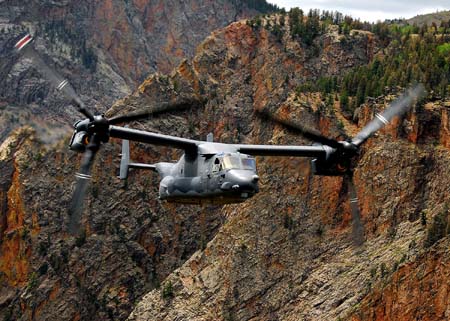There are Navy restrictions that  prevent V-22 Osprey pilots from realizing the full potential of the aircraft to avoid air defense missiles, reports the Web journal DOD Buzz. A “Marine officer who is very knowledgeable on the subject of V-22 survivability,” which at least one Congressman and the Government Accountability Office recently called into question, told DOD Buzz, that the Naval Air Training and Operating Procedures Standardization currently prohibits pilots from using a simple defensive maneuver—pitching the aircraft’s nose up 20 degrees or more—to get out of the threat zone. He told reporter Greg Grant, “Every tactical pilot knows that success in defensive maneuver requires two elements: expendables plus maneuver.” He explained that after throwing out a decoy, “you displace yourself in as many axes as you can to provide the biggest solution problem for the missile.” The officer noted, too, that most Marine Corps Osprey pilots are former helicopter pilots who trained to fly straight and level in a threat zone, using a variety of onboard defenses to thwart missiles, so need to train how to best maneuver the aircraft in a threat environment. Last month, Gen. James Conway, Marine Corps Commandant, told House defense appropriators that an MV-22 force is still on track to deploy this fall to Afghanistan, following three successful deployments to Iraq, where the Osprey “exceeded our expectations.”
prevent V-22 Osprey pilots from realizing the full potential of the aircraft to avoid air defense missiles, reports the Web journal DOD Buzz. A “Marine officer who is very knowledgeable on the subject of V-22 survivability,” which at least one Congressman and the Government Accountability Office recently called into question, told DOD Buzz, that the Naval Air Training and Operating Procedures Standardization currently prohibits pilots from using a simple defensive maneuver—pitching the aircraft’s nose up 20 degrees or more—to get out of the threat zone. He told reporter Greg Grant, “Every tactical pilot knows that success in defensive maneuver requires two elements: expendables plus maneuver.” He explained that after throwing out a decoy, “you displace yourself in as many axes as you can to provide the biggest solution problem for the missile.” The officer noted, too, that most Marine Corps Osprey pilots are former helicopter pilots who trained to fly straight and level in a threat zone, using a variety of onboard defenses to thwart missiles, so need to train how to best maneuver the aircraft in a threat environment. Last month, Gen. James Conway, Marine Corps Commandant, told House defense appropriators that an MV-22 force is still on track to deploy this fall to Afghanistan, following three successful deployments to Iraq, where the Osprey “exceeded our expectations.”
Boeing received a $2.47 billion Air Force contract Nov. 25 for 15 more KC-46s, bringing to 183 the number of Pegasus tankers on contract to all customers, foreign and domestic. The new contract—for Lot 12 of the initially planned KC-46 buy—is to be completed by 2029.



